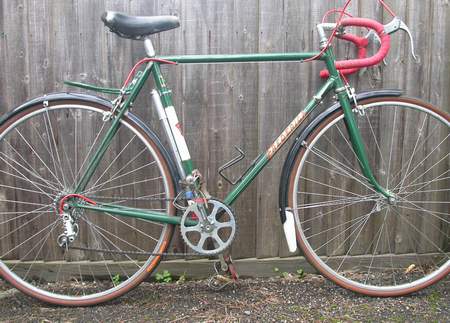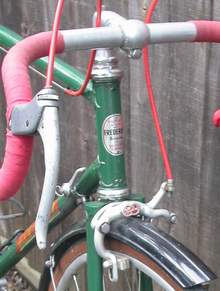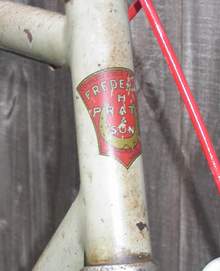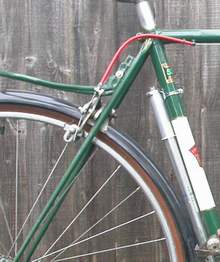Pratt, Frederick
Posted: Thursday 04th June 2020
Frederick Pratt & Son, a small bicycle shop in leafy Surrey, opened for business in late 1948. The shop was in Salfords, a small village on the A23 just a few miles south of Redhill – and therefore not as leafy as you might think, and served the locality well for over fifty years before closing recently, on 31 January 2003. The firm was created by Frederick Harold Pratt, under whom all the bicycles carrying his name were made. Frederick’s son, Philip Noel Pratt, continued operating the shop until his own recent retirement, but no more bicycles were ever made. It was as if the cast had been broken on his death!
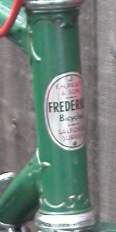
The family firm of Frederick Pratt and Son was opened on 19 July 1948, with its first advertisement in Cycling in September 1948. Frederick understood the importance of cycle sporting contacts to small cycle shops and the Redhill Cycle Club, which had been formed in 1945, and the Crawley base club, the Southern Wheelers, were doubtless part of his plan. Frederick was also a keen CTC member and supporter. It was not long before the shop-front carried the attractive CTC winged wheel emblem and the National Clarion official repairer’s sign.
Fred had a proselytising streak to his nature and fresh in the new shop were four leaflets setting out his views of cycle design. These were based on his belief that the prevalent tendency to ‘upright’ frames with steep angles had led to unstable and uncomfortable cycles to which unsuspecting clubmen were being subjected. His proposed solution was a frame designed with relaxed frame angles and a long rear triangle. This was based upon his own racing bike head and seat tube angles about 68ºand 65º respectively, and Fred also gave it a long wheel-base using a specially long rear triangle of 26 inches. This style became known as the Frederick Jack Knife. It is best to draw a line in the sand at this point as this venture never took off although some (an unknown quantity probably less than 10) Jack Knife bikes were ever made. They make a fascinating story but none have survived.
After about a year Frederick Pratt took on a new frame builder Peter Tester and from 1949 Pete was responsible for all of the Frederick bicycles made until 1967 when Frederick Pratt died and Pete left the firm. Pete’s building technique, learnt from Fred who built the first couple of frames with him, was to hand saw the mitres using, as his eye became more expert, just two cuts per mitre, and attempting to get a perfect fit with the minimum of filing. Starting first with the top tube and head, then using a ‘unique-to-the-customer’ paper drawing which was taped to a plate glass, the frame main triangle was laid out, then brazed up with the key joints pegged with framing pins. Pete recalled the lugs were Haden or plainer Prugnat type at that time with the imported Nervex lugs only available later.
All frames were made in Reynolds double-butted 531 except where unusual tube strength was needed. In the early days it was normal for a batch of frames to be made and then taken to be sand blasted in South London by a one-man-band company who passed the frames to be stoved enamelled by Claud Butler’s, who were known at that time for the quality of their frame enamelling. Later, after the Claud Butler factory closed, another small enameller, James Gray in Tooting, took on the work. Later again, James Gray closed and the frames then went to Holdsworth for all finishing work.
The shop tended to fit to a customer’s frame what the trade supplied, or if they were well-heeled, what they read about in the cycling journals of the time. What is now, some 50 years later, thought of as fairly ordinary gear was normal – Williams C34 or may be C1000 and Phillips or GB brakes. In this area the continental exotica was to all intents and purposes unobtainable for mortals on normal salaries.
The frame numbering system was as follows. For example, 58113, shows Y/m/x where Y (58) is year, m is month (11), and x is the consecutive frame number within the year. The system was maintained for the first ten years from 1951 to 1960, but thereafter the system was simplified to Y/x with the month omitted. The month shown is the month when the shop completed the frame; the frame would have been delivered a few weeks to a month later after sending to shotblaster and sprayer for finishing.
There is a good example of a 1952 Frederick in Readers’ Bikes.
More on Frederick Pratt: The Frederick Bicycle Shop and details of Alvin’s book
Posted: Thursday 04th June 2020
This article appears in the following categories.
Upcoming Events
Whether you are looking for a gentle social meet up, or a 100-mile ride browse the community’s upcoming events and plan your next weekend outing.

